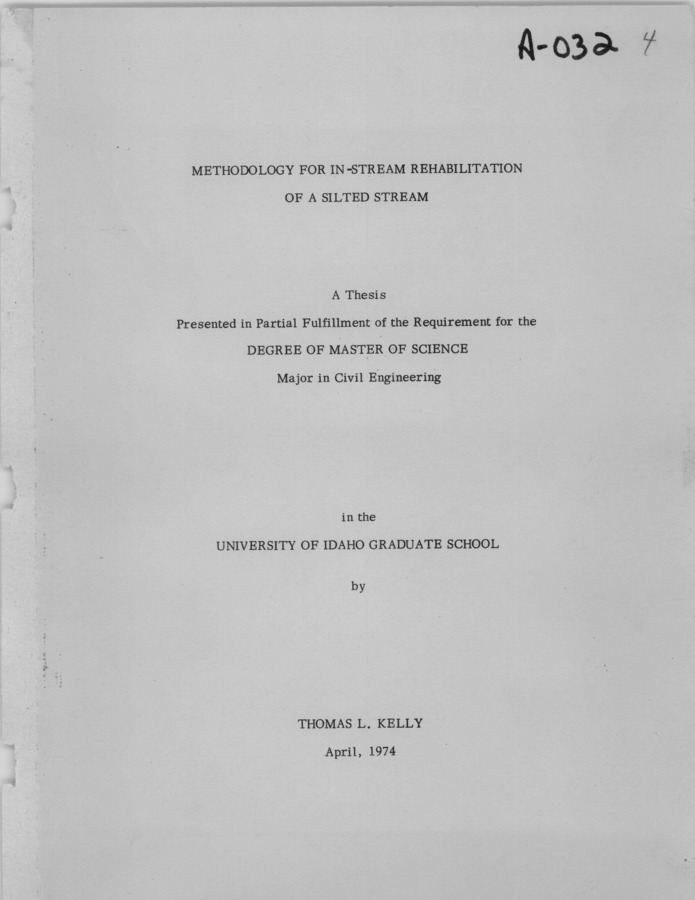PDF
Methodology for in-stream rehabilitation of a silted stream Item Info
- Title:
- Methodology for in-stream rehabilitation of a silted stream
- Authors:
- Kelly, Thomas L.
- Contributors:
- Idaho Water Resources Research Institute; IWRRI
- Date:
- 1974-04
- Description:
- The purpose of this project was to develop methodology for rehabilitating streams where the fishery and other recreational uses have been destroyed or greatly reduced by heavy silting. Using Emerald Creek in northern Idaho as a study stream two types of in-stream modification structures, flow constrictors and drop structures, were designed, constructed and evaluated. Contour maps and thalweg profiles of the before and after modification conditions are presented for each of the five stream modification sites. Three drop structures were constructed at two sites on the upper reach of Emerald Creek. These structures concentrate the energy of the flow and scour a hole downstream of the structure. Considerations in the design of drop structures include forces on the structure, backwater caused by the structure, and depth of scour below the structure. In general the log drop structures per formed favorably. Scour holes formed downstream of two of the drop structures to a depth of 1.0 ft and 1.5 ft as compared to a predicted scour depth of 2.0 ft and 3.0 ft respectively. The scour holes were lined with rock from six to ten inches in diameter. The flow constricting structures were designed to reduce the width and increase the depth of flow during low flow periods to increase the sediment transport capacity of the stream thus flushing the silts and fine sands from the modified reach leaving cobble and small boulders. Gabion deflectors were used at two sites on the lower reach of Emerald Creek to constrict the flow. Log dikes were used at one site to constrict the flow and train the stream to follow a meandering flow path. Design considerations for flow constrictors include forces on the structure, location of structure, meander dimensions, and constriction dimensions. The performance of the gabion constrictors was acceptable at one site. Silts and sands were removed from the reach leaving cobble and boulders. Performance at the other gabion constrictor site was fair. Small amounts of silt and sand were removed from the reach. Cobble and small boulders moved into the constricted flow area from an upstream riffle. The log dikes used to form a meandering flow pattern during low flow appeared to be functioning as planned but were removed by high flows before analysis of the modification was completed. A method for measuring the streambed hydraulic conductivity using standpipes is suggested as a means for determining the change in bed characteristics resulting from deposition of silt. Calibration curves for the standpipes were developed in the laboratory for future testing in the field.
- Subjects:
- silting rehabilitation sediment control
- Location:
- Emerald Creek
- Idaho County:
- Shoshone County
- Latitude:
- 47.06
- Longitude:
- -116.32
- Collection:
- IWRRI
- Source:
- Idaho Water Resources Research Institute, University of Idaho
- Identifier:
- IWRRI Number 197416
- Publisher:
- Idaho Water Resources Research Institute, University of Idaho
- Contributing Institution:
- University of Idaho
- Type:
- Text
- Format:
- application/pdf
- Cataloger:
- wbv
- Date Digitized:
- 2012
- Language:
- eng
Source
- Preferred Citation:
- "Methodology for in-stream rehabilitation of a silted stream", Idaho Waters Digital Library, University of Idaho Library Digital Collections, https://www.lib.uidaho.edu/digital/iwdl/items/iwdl-kelly_1974.html
Rights
- Rights:
- In copyright, educational use permitted. Educational use includes non-commercial reproduction of text and images in materials for teaching and research purposes. For other contexts beyond fair use, including digital reproduction, please contact the University of Idaho Library Special Collections and Archives Department at libspec@uidaho.edu. The University of Idaho Library is not liable for any violations of the law by users.
- Standardized Rights:
- http://rightsstatements.org/vocab/InC-EDU/1.0/

